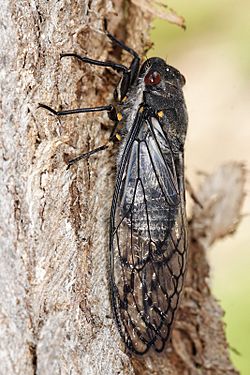Redeye facts for kids
Quick facts for kids Redeye |
|
|---|---|
 |
|
| Redeye on a eucalypt | |
| Scientific classification | |
| Kingdom: | |
| Phylum: | |
| Class: | |
| Order: | |
| Family: |
Cicadidae
|
| Genus: |
Psaltoda
|
| Species: |
P. moerens
|
| Binomial name | |
| Psaltoda moerens (Germar)
|
|
The redeye (scientific name: Psaltoda moerens) is a type of cicada found in Australia. You can find them in the south-east parts of Australia. This includes southern Queensland, New South Wales, Victoria, South Australia, and Tasmania.
Sometimes, there are lots of redeyes in one year. Other years, you might not see any at all! They mostly eat sap from eucalyptus trees. They also like Angophora trees. When many redeyes are feeding, they can drip small amounts of clear waste fluid. This can look like a constant shower.
Contents
What is a Redeye Cicada?
The redeye cicada was first described in 1834 by a German scientist named Ernst Friedrich Germar. He called it Cicada moerens. Later, it was moved to a new group called Psaltoda. A Swedish scientist, Carl Stål, made it the main example for this new group.
In 1907, Walter Wilson Froggatt wrote about insects in Australia. He said that children in Sydney called this cicada the "redeye." This name came from the bright red color of its eyes.
How to Spot a Redeye Cicada
Redeye cicadas are quite large. Their wings can spread about 110 to 120 millimeters wide. The top of their body is shiny black. Their underside is brown and a bit hairy.
As their name suggests, their eyes are usually a deep red. However, some redeyes might have pinkish or brownish eyes instead.
The Redeye's Unique Sound
You can hear the redeye's call at any time of day. It sounds like a series of "revving" noises. There are usually two to twelve revs, often around six. These revs have a "yodelling" sound. After the yodelling, they make a continuous rattling noise. The redeye makes the yodelling sound by bending its belly upwards.
Where Do Redeye Cicadas Live?
You can find redeye cicadas from November to February. They live in the New England area of south-east Queensland. They also live across New South Wales, Victoria, and south-eastern South Australia. You can even find them in Eastern and Northern Tasmania.
They live in higher places in the northern parts of Australia. In the southern parts, they live closer to sea level. In western Sydney, they don't appear every summer.
Redeye's Favorite Trees
Redeyes prefer open forests with hard-leaved trees. They especially like smooth-barked eucalyptus trees and Angophora species. If those aren't available, they will settle for trees with rough bark.
Some of their favorite trees include:
- Sydney red gum (Angophora costata)
- Scribbly gum (Eucalyptus racemosa)
- Grey box (E. moluccana)
- Narrow-leaved apple (Angophora bakeri)
- Manna gum (Eucalyptus viminalis)
- Messmate stringybark (Eucalyptus obliqua)
They have also been seen on trees that are not native to Australia. These include the liquidambar (Liquidambar styraciflua), Japanese maple (Acer palmatum), and weeping willow (Salix babylonica).
Redeyes like to sit on the smooth parts of tree trunks. Many thousands of redeyes might gather on just a few trees. They might ignore other trees nearby.
Redeye Cicada Behavior
Redeyes use their mouthparts to poke holes in tree bark. They can feed for many hours at a time. As they feed, they get rid of waste fluid. If there are many redeyes, this fluid can fall like a constant shower. Redeyes are also attracted to bright lights. Female redeyes lay their eggs only in dead or dying plant parts.
Who Eats Redeye Cicadas?
The redeye cicada is a favorite food for the noisy friarbird. This bird swallows the cicada whole, head-first! The bird's mouth is just the right size for these cicadas.
Another animal that hunts the redeye is the cicada killer wasp (Exeirus lateritius). This wasp stings the cicada to make it unable to move. Then, the wasp takes the cicada back to its burrow. It lays an egg next to the cicada. When the wasp larva hatches, it eats the cicada.

